Paulus Hector Mair, Opus amplissimum de arte athletica..., c1510-1550
Notes on the Paulus Hector Mair
 Note: Permission to publish the manuscript online on the AEMMA's online library was graciously granted by the Österreichische Nationalbibliothek. The images are available for scientific and academic research purposes only and remain the property of Österreichische Nationalbibliothek. Any desire to publish this material elsewhere or for profit must be approved by the university.
Note: Permission to publish the manuscript online on the AEMMA's online library was graciously granted by the Österreichische Nationalbibliothek. The images are available for scientific and academic research purposes only and remain the property of Österreichische Nationalbibliothek. Any desire to publish this material elsewhere or for profit must be approved by the university.
Paulus Hector Mair (1517–1579) was an Augsburg civil servant, and active in the martial arts of his time. He collected Fechtbücher and undertook to compile all knowledge of the art of fencing in a compendium surpassing all earlier books. For this, he engaged the painter Jörg Breu the Younger, as well as two experienced fencers, whom he charged with perfecting the techniques before they were painted. The project was very costly, taking full four years, and according to Mair, consumed most of his family's income and property. Three versions of his compilation, and one later, less extensive manuscript, have been preserved.
Not only did Mair spend huge sums on his collections and on his projects, he also had a very expensive lifestyle, frequently hosting receptions for the more important burghers of Augsburg. His own income was not sufficient for this, and during many years, he misappropriated funds from the city treasury, with the supervision of which he had been entrusted since 1541. His embezzlements were discovered in 1579, and Mair was hanged as a thief at the age of 62.
This German manuscript, dated approximately 1510 - 1550 contains over 600 leafs of illustrations and text depicting various forms of engagements, of pairs of unarmoured individuals engaged in 2-hander swords, dussack, short-staff, quarter-staff, pole-axe and dagger techniques. The manuscript is one of the most heavily scripted manuscripts, which appears to have been written by two different individuals. Under each illustration, are two paragraphs, the first written by one of the writers is written entirely in Latin, while the second paragraph describing the same illustration, is written by a second writer, in German.
Note #1: The manuscript is presented in a book format. Click on either the left page or right page of the book presentation to view an enlargement of the page for closer examination.
Notice: Click here for details on registering with AEMMA and obtaining your Online Library electronic card.
 |
1.0 Plates 00-15: Manuscript Start
The first 15 plates of this manuscript is comprised of two sections. The first seven (7) leaves are written in Latin, followed by 18 leaves written in High German. The Latin section begins with the page entitled "Prefatio in Athleticam" or "Preface in Athletics". The second German section is entitled "Vorred in das Fechtbüch" or "Preface into the Fight Book" and ends on a very religious note with "Amen" which doesn't appear in the Latin portion. And finally, below the "Amen" conclusion, is a figure that is impossible to identify, perhaps a crest, and below that is Paulus Hector Mair's name, which seems to indicate that it was written originally in Augsburg. The differences in handwriting styles is readily apparent between these two sections. At this time, there are no known translations available of this manuscript.
Note: If you should be interested in working on a translation of this manuscript, please do contact AEMMA at . We would be interested in a collaborative work effort. |
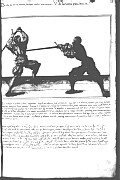 |
2.0 Plates 16-85: Two-hander Sword Techniques
A huge and detailed collection of unarmoured 2-hander sword techniques, complete with Latin and German descriptive text. An interesting page illustrates a footstab on plate 20 which is reminiscent of Talhoffer's illustration found in tafel 45 in the fechtbüch entited "Fechtbüch aus dem Jahre 1467", and the 5th plate of Jakob Sutor's manuscript entitled "Künstliches Fechtbüch" written in 1612. A very good example of a classic grip on plate 30 in which one would move in quickly and at the beginning of the strike, grip the opponent's elbow preventing the arm from raising up and delivering a downward strike. A most unusual defensive posture can be seen in plate 48 L depicting both individuals holding their swords vertically, tip on the floor. The Latin title for this plate is "Custodia Cancellata" which is roughly translated to "Barrier Guard". Plate 57R depicts one of the individuals in which he has tossed his sword aside, and then gripping the opponent behind both knees which is very reminiscent of plate 18 (as seen in the pdf file) found in Jakob Sutor's manuscript entitled "Künstliches Fechtbüch", 1612. |
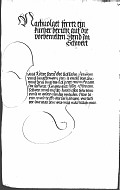 |
3.0 Plates 87-106: German Text Section - Plates 108-113 : Latin Text Section
This section includes 19 plates of German text, broken up into discrete sections which concludes with plate 116. Immediately following this German section is Latin text occupying 5 1/2 pages concluding with the beginning of the dussack section. It begins with a page entitled "Breuis habituum Enfis longioris expofitio." which loosely translates to "A brief demonstration on longsword forms (techniques).". It is not clear if this Latin text is a translation of the preceding German text, however, with limited German, the German section title does include "schwert" which implies that might possess similar content to the Latin section. |
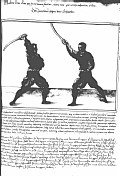 |
4.0 Plates 113-135: Dussack Techniques
This section begins with the page entitled "Der Zornhaus gegen dem Schaitlez" which roughly translates to "The cut of wrath goes with (schaitlez)". The stances with the dussack and the techniques illustrated are again, common to those found in Jakob Sutor's manuscript entitled "Künstliches Fechtbüch", 1612, however, Mair's manuscript is far more extensive on the subject of dussack than Sutor's. For example, plate 114L is very similar to Sutor's plate 25, and plate 117R to Sutor's plate 29. Continuing with some notable similarities, in plate 123L, the individual's posture on the right is a classic dussack position, which is very similar to plate 34 in Sutor's manuscript. Another notable illustration is found on plate 124R, which depicts the left individual deploying what appears to be a "half-sword" technique with the dussack, which doesn't appear in the Sutor's manuscript. |
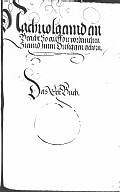 |
5.0 Plates 136-163: German Text Section - Plates 165-171 : Latin Text Section
Another text section, first beginning with 27 plates of German text followed by 6 plates of Latin text. The Latin portion begins with a page entitled "Verissima et artificiosissima exercendi Athletucam per Acinarem, hor est ensem breuiorem, descriptio" which loosely translates to "This is a brief Athletic description of a realistic and skillful sword training for /Acinarem/." It is not clear if the word Acinarem is in fact a name of a person for which this text was written for or it has another meaning. The translation confidence of this text is about 70%. |
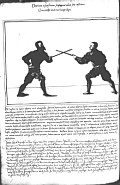 |
6.0 Plates 172-183: Short-staff Techniques
This section of the manuscript covers what appears to be a short-staff. This is an uncommon weapon, covered in one or two other known manuscripts, such as a few pages in Sutor's "Künstliches Fechtbüch", specifically plates 89-93 in his manuscript. In some of the illustrations, the grips look similar to those of half-staff techniques. The staff appear to be no more than 2m in length, which is much shorter than the traditional quarter-staff. |
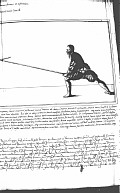 |
7.0 Plates 184-194: Quarter-staff Techniques
A detailed descriptive section on quarter-staff techniques. The first plate depicts the classic "medium guard" or "middle guard" postures. Many of these forms are both illustrated and described in an excellent reference book written by Terry Brown entitled "English Martial Arts". Most of the techniques presented, if not all, can be directly transcribed to the pole-axe. It is more than a coincidence that the quarter-staff section precedes the pole-axe section. |
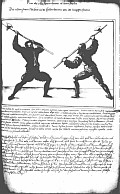 |
8.0 Plates 195-206: Pole-axe Techniques
Coverage of the pole-axe can be found in numerous other manuscripts including Hans Talhoffer's "Alte Armatur und Ringkunst", 1459, in which the pole-axe is covered in verso 71. Another manuscript with pole-axe coverage is Hans Talhoffer "Fechtbüch aus dem Jahre 1467", with pole-axe beginning with tafel 79. A final reference to other manuscripts that cover pole-axe is Sutor's manuscript entitled "Künstliches Fechtbüch" where the pole-axe begins on page 95. |
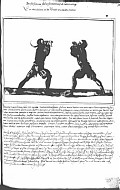 |
9.0 Plates 206-214: Sickle Techniques
An unusal presentation of single-handed sickle or "sichel" techniques. The techiques appear very similar 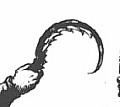 to knife/dagger techniques except for the additional feature of hooking the opponent's arm or body as illustrated in the manuscript. A close-up of the serrated sickle on the left clearly indicates the serrated edge it possesses. It is unclear if this is a "civilian" object or farm implement that is being used, or whether this weapon has been created specifically for this form of fighting. With the known available manuscripts, there does not appear to be any other instance of the sickle. Clues may be hidden in the accompanying text of the illustrations. to knife/dagger techniques except for the additional feature of hooking the opponent's arm or body as illustrated in the manuscript. A close-up of the serrated sickle on the left clearly indicates the serrated edge it possesses. It is unclear if this is a "civilian" object or farm implement that is being used, or whether this weapon has been created specifically for this form of fighting. With the known available manuscripts, there does not appear to be any other instance of the sickle. Clues may be hidden in the accompanying text of the illustrations. |
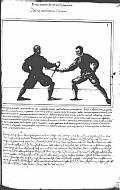 |
10.0 Plates 214-246: Dagger Techniques
Classic illustrations of knife techniques, that include parrying,  capture, disarm and binding techniques. A notable attribute of the daggers employed is that the the blades are ball-tipped as illustrated in the figure on the left (an extract from one of the pages of Mair's manuscript). This construction of the dagger appears to be unique to Mair's manuscript (at least with the known manuscripts) and is the first instance of an obvious training weapon being employed to depict the maneuvres. A variation of the dagger appears in plate 238, where the design of the dagger no longer appears to be a loose "rondel" design and does not have the safety ball attached to the tip. capture, disarm and binding techniques. A notable attribute of the daggers employed is that the the blades are ball-tipped as illustrated in the figure on the left (an extract from one of the pages of Mair's manuscript). This construction of the dagger appears to be unique to Mair's manuscript (at least with the known manuscripts) and is the first instance of an obvious training weapon being employed to depict the maneuvres. A variation of the dagger appears in plate 238, where the design of the dagger no longer appears to be a loose "rondel" design and does not have the safety ball attached to the tip. |
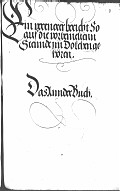 |
11.0 Plates 248-273: German Text Section - Plates 275-280 : Latin Text Section
What appears to be the concluding text of the manuscript that describes the dagger techniques in the previous illustrated section. The Latin text (my ability to translate Latin is stronger than German!), is entitled "Instructio, qua y qui pugione student athleticam exercere, diligenter observare debent." which roughly translates into "Instructions for the athletic student who will carefully observe the how and why dagger techniques in order to fight it out to its conclusion." which possibly means that through careful study of the techniques, the student is able to successfully conclude any engagement that involves the dagger. |
 Note: Permission to publish the manuscript online on the AEMMA's online library was graciously granted by the Österreichische Nationalbibliothek. The images are available for scientific and academic research purposes only and remain the property of Österreichische Nationalbibliothek. Any desire to publish this material elsewhere or for profit must be approved by the university.
Note: Permission to publish the manuscript online on the AEMMA's online library was graciously granted by the Österreichische Nationalbibliothek. The images are available for scientific and academic research purposes only and remain the property of Österreichische Nationalbibliothek. Any desire to publish this material elsewhere or for profit must be approved by the university.








 to knife/dagger techniques except for the additional feature of hooking the opponent's arm or body as illustrated in the manuscript. A close-up of the serrated sickle on the left clearly indicates the serrated edge it possesses. It is unclear if this is a "civilian" object or farm implement that is being used, or whether this weapon has been created specifically for this form of fighting. With the known available manuscripts, there does not appear to be any other instance of the sickle. Clues may be hidden in the accompanying text of the illustrations.
to knife/dagger techniques except for the additional feature of hooking the opponent's arm or body as illustrated in the manuscript. A close-up of the serrated sickle on the left clearly indicates the serrated edge it possesses. It is unclear if this is a "civilian" object or farm implement that is being used, or whether this weapon has been created specifically for this form of fighting. With the known available manuscripts, there does not appear to be any other instance of the sickle. Clues may be hidden in the accompanying text of the illustrations.
 capture, disarm and binding techniques. A notable attribute of the daggers employed is that the the blades are ball-tipped as illustrated in the figure on the left (an extract from one of the pages of Mair's manuscript). This construction of the dagger appears to be unique to Mair's manuscript (at least with the known manuscripts) and is the first instance of an obvious training weapon being employed to depict the maneuvres. A variation of the dagger appears in
capture, disarm and binding techniques. A notable attribute of the daggers employed is that the the blades are ball-tipped as illustrated in the figure on the left (an extract from one of the pages of Mair's manuscript). This construction of the dagger appears to be unique to Mair's manuscript (at least with the known manuscripts) and is the first instance of an obvious training weapon being employed to depict the maneuvres. A variation of the dagger appears in 